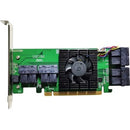Description
The HighPoint SSD7180 NVMe Controller is a robust, high-port-count RAID solution engineered to transform NVMe storage into scalable, enterprise-grade performance. Designed to meet the demands of data centers, media professionals, and power users, this controller delivers eight NVMe channels for parallel data paths that dramatically boost throughput while sustaining writes under heavy workloads. With flexible deployment options for U.2 and M.2 form factors, it provides platform independence for both AMD and Intel ecosystems, making it a versatile choice for building mass storage arrays, accelerating workloads, and simplifying storage scalability. Whether you’re optimizing a virtualization host, handling large-scale backups, or crafting a fast, reliable storage pool, the SSD7180 is built to maximize NVMe performance with reliability and ease of management.
- 8-channel architecture for scalable performance: The SSD7180 leverages eight NVMe channels to enable parallel data transfer, unlocking higher aggregate bandwidth and improved sustained write performance across multiple drives in RAID configurations. This design minimizes bottlenecks and helps maintain consistent throughput, even under demanding workloads.
- Flexible form factors for versatile deployments: Available for U.2 and M.2 form factors, the SSD7180 supports a wide range of server, workstation, and backplane configurations. This flexibility allows you to tailor your storage topology—from compact workstations to large-rack servers—without compromising on speed or capacity.
- Platform-independent compatibility: Engineered as a truly platform-independent NVMe RAID solution, the SSD7180 works seamlessly with both AMD and Intel systems. This broad compatibility simplifies upgrades, mergers of existing storage environments, and long-term planning for diverse hardware ecosystems.
- Mass storage focus with high-sustained write performance: Built to handle data-intensive workloads, the SSD7180 delivers high-sustained write performance across NVMe drives. This makes it an excellent choice for workloads that require large, sustained write throughput, such as video editing, database operations, virtualization storage, and large-scale backups.
- Advanced RAID capabilities and reliability: The controller is designed to manage NVMe RAID arrays with data protection, efficient rebuild procedures, and robust management features. It enables secure, resilient storage pools that minimize downtime while maximizing performance and capacity utilization.
Technical Details of HighPoint SSD7180 NVMe Controller
- Channel count: 8 NVMe channels enabling parallel data transfer and higher aggregate throughput.
- Interface: PCIe 3.0, optimized for high-speed NVMe data paths and efficient RAID operations.
- Form factor options: Available for U.2 and M.2 deployments to fit servers, workstations, and backplane configurations.
- RAID capabilities: NVMe RAID controller with management features to configure arrays, monitor health, and protect data across NVMe SSDs.
- Platform compatibility: Truly platform independent, compatible with both AMD and Intel systems for flexible deployment.
- Target workload: Designed for mass storage workloads with high-sustained write performance and reliable throughput in RAID configurations.
How to install HighPoint SSD7180 NVMe Controller
Installing the SSD7180 is a straightforward process designed to minimize downtime and maximize performance gains. Follow these general steps to deploy the controller in a compatible system and configure your NVMe RAID array for optimal performance and reliability.
- Power down the system, unplug the power cord, and discharge any static electricity before handling hardware.
- Open the chassis and identify a compatible PCIe slot. The SSD7180 supports PCIe 3.0 configurations; select an appropriate slot (x4, x8, or higher as recommended by your motherboard and the controller’s specifications) and secure the card with a screw.
- Install the SSD7180 into the chosen PCIe slot, ensuring it seats firmly and aligns properly with the backplane or motherboard connectors.
- Attach NVMe drives to the controller through the designated ports or connect via a U.2 backplane if your configuration uses U.2 form factors. Ensure all drives are properly seated and recognized by the system.
- Power on the system and enter the BIOS/UEFI to confirm that the SSD7180 is detected. If required, install the HighPoint management software and/or drivers provided by the manufacturer to enable advanced RAID features and monitoring.
- Boot into your operating system and use the HighPoint NVMe RAID management utility to configure your RAID array (e.g., RAID 0/1/5/6/10 or other supported configurations). Initialize drives as needed and assign appropriate array names and caching options if available.
- Install the operating system on a bootable drive if desired, or designate the array for data storage. Test the array with benchmark tools to verify performance and stability, and set up monitoring alerts for drive health, temperatures, and rebuild status.
Frequently Asked Questions
- Q: What is the HighPoint SSD7180? A: It is an 8-channel PCIe 3.0 NVMe RAID controller designed for mass storage with U.2 and M.2 form factors and platform-independent compatibility for AMD and Intel.
- Q: Which platforms does it support? A: It is designed to be platform independent, working with both AMD and Intel systems, and is suitable for servers, workstations, and high-performance storage deployments.
- Q: What form factors are available? A: The SSD7180 is available for U.2 and M.2 deployments, enabling flexible integration with backplanes and direct-attached NVMe SSDs.
- Q: What RAID levels does it support? A: The controller provides NVMe RAID management for common RAID configurations; exact RAID level support depends on the software/firmware version, but it is designed to optimize data protection and performance across arrays.
- Q: Do I need drivers or management software? A: Yes, to access the controller’s full capabilities and configure arrays, install the recommended management software and drivers from HighPoint. This ensures proper detection, monitoring, and performance tuning.
Customer reviews
Showing - Of Reviews


